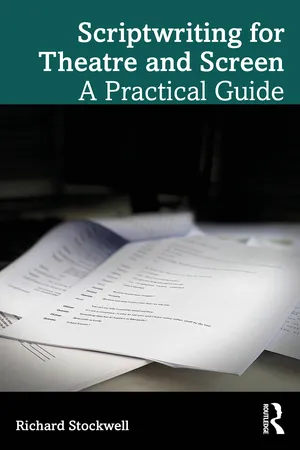
- English
- ePUB (mobile friendly)
- Available on iOS & Android
About this book
Scriptwriting for Theatre and Screen: A Practical Guide is an introduction designed to help readers understand the nature of dramatic scriptwriting and quickly guide them to a place where they can write, first a short play, and then a short screenplay.
The book clearly points out not only the differences between writing for the stage and writing for the screen, but also the shared skills and the fundamental dramatic principles that unite them. The two sections (Theatre Writing and Screenwriting) are connected by a bridging chapter that explores similarities and differences between the two media. The chapters are arranged with a short introductory essay on topics such as generating ideas, structure, character, modes of address, empathy, status, visual writing, and revising and editing, followed by practical exercises with exemplar responses – including a sample short play and film. Two additional chapters address how to approach writing a self-reflexive commentary, explore how the skills covered can be applied to writing for television, and explain other skills a writer might need to develop when working in this industry.
This complete introduction to writing dramatic scripts is intended for students of playwriting and screenwriting but is also suitable for all writers new to these areas and interested in developing their skills.
Frequently asked questions
- Essential is ideal for learners and professionals who enjoy exploring a wide range of subjects. Access the Essential Library with 800,000+ trusted titles and best-sellers across business, personal growth, and the humanities. Includes unlimited reading time and Standard Read Aloud voice.
- Complete: Perfect for advanced learners and researchers needing full, unrestricted access. Unlock 1.4M+ books across hundreds of subjects, including academic and specialized titles. The Complete Plan also includes advanced features like Premium Read Aloud and Research Assistant.
Please note we cannot support devices running on iOS 13 and Android 7 or earlier. Learn more about using the app.
Information
Table of contents
- Cover Page
- Half-Title Page
- Title Page
- Copyright Page
- Dedication Page
- Contents
- Acknowledgements
- Introduction: How to Use This Book
- PART 1: Theatre Writing
- PART 2: Screenwriting
- Appendix 1: Critical Commentaries: Evaluations
- Appendix 2: Some More Writing Exercises
- Index